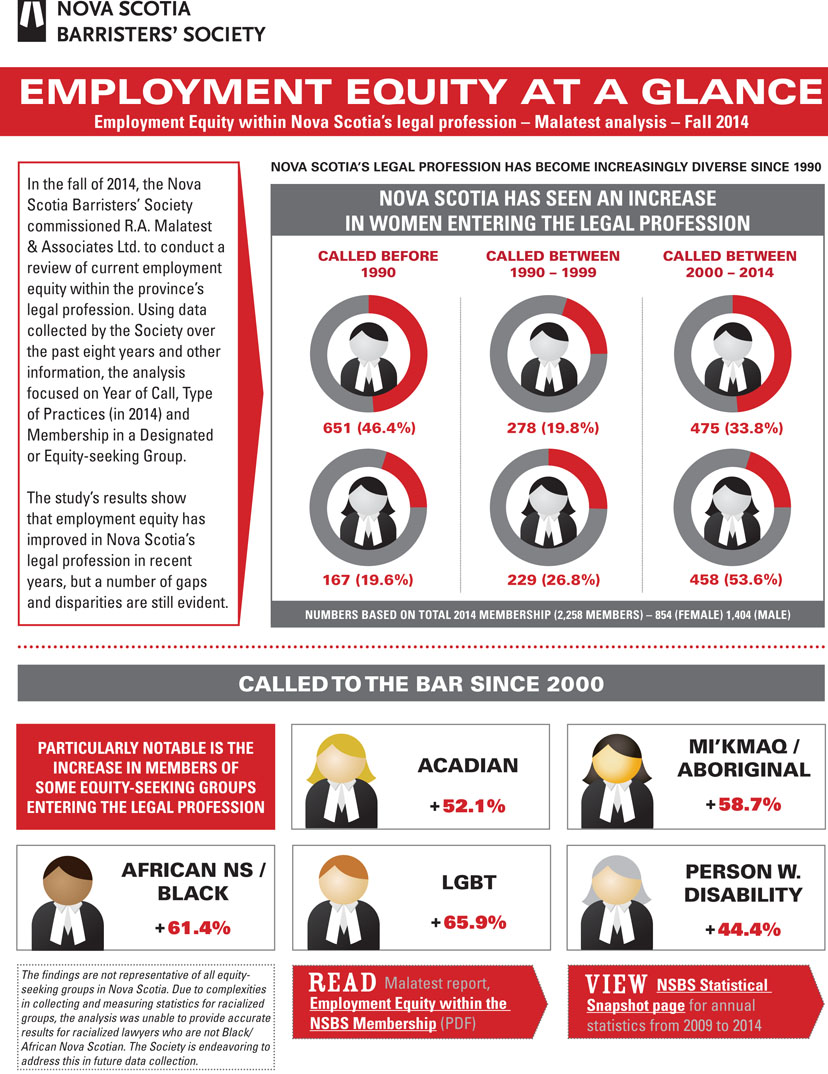The legal profession in Nova Scotia is steadily becoming more diverse, although a new
study shows the gains are more noticeable in the public sector than at private law firms.

Nearly 50 per cent of lawyers in the province called to the bar since 2000 are female. Almost 15 per cent of calls during that period are identified as part of “equity-seeking groups,” states the study commissioned by the Nova Scotia Barristers’ Society.
The survey is part of long-standing efforts by the organization to improve employment equity in the legal profession in the province. It is the first time that it has commissioned an analysis of the demographics of lawyers in Nova Scotia.
“Before, we did not have good data,” says NSBS president Tilly Pillay. “We have never been able to have numbers and statistics. This is a good start,” she says.
The survey shows while there has been an increase in the number of female lawyers, as well as those who identify as Acadian, African NS/Black, Mi’kmaq/Aboriginal, LGBT, or as a person with a disability — the changes have been very gradual over the past two decades.
As well, the current data indicates male lawyers are more likely to be a partner in a law firm, while female colleagues are counsel for a government ministry of public sector organization.
About one-quarter of the 1,404 male lawyers in the province are partners in a law firm, compared to 12 per cent of the 854 female lawyers. Nearly 30 per cent of female counsel are employed in the public sector.
One-in-five people within one of the equity-seeking groups is a partner in a law firm, which is about the same percentage as those working in the public sector.
The study, conducted by R.A. Malatest & Associates Ltd., concludes there is an “overall improvement in employment equity” within the province. While much of this improvement is in the public sector, “there are indications that private firms are becoming more accessible to members of designated groups,” the study concludes.
Increasing the diversity within certain sectors of the legal profession, “is never as quick as we want,” says Pillay, who is also executive director of the legal services division at the provincial Department of Justice.
However, the data compiled in the study is useful when “urging legal employers to have this foremost in their minds,” says Pillay.
“I think it is getting traction that diversity is also good business for law firms,” she suggests. If a firm better reflects the demographics of a community, “people in these communities will turn to you for legal advice,”
Pillay is also optimistic the rate of change will accelerate.
“As people remain in the profession, they will also be mentors and role models. Things will happen much more quickly than in the past 20 years,” she says.

 Nearly 50 per cent of lawyers in the province called to the bar since 2000 are female. Almost 15 per cent of calls during that period are identified as part of “equity-seeking groups,” states the study commissioned by the Nova Scotia Barristers’ Society.
Nearly 50 per cent of lawyers in the province called to the bar since 2000 are female. Almost 15 per cent of calls during that period are identified as part of “equity-seeking groups,” states the study commissioned by the Nova Scotia Barristers’ Society.